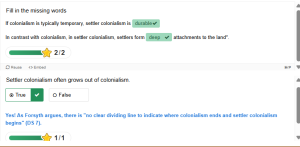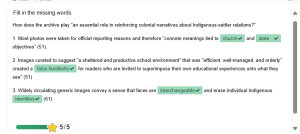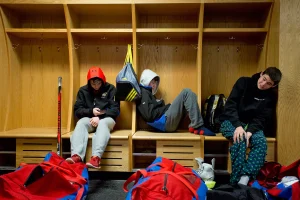4
These are difficult stories. We bear witness in this chapter to the role of sport in furthering the settler colonial projects throughout Turtle Island. Here are some supports to access in the community and from a distance:
First Peoples House of Learning Cultural Support & Counselling
Niijkiwendidaa Anishnaabekwag Services Circle (Counselling & Healing Services for Indigenous Women & their Families) – 1-800-663-2696
Nogojiwanong Friendship Centre (705) 775-0387
Peterborough Community Counselling Resource Centre: (705) 742-4258
Hope for Wellness – Indigenous help line (online chat also available) – 1-855-242-3310
LGBT Youthline: askus@youthline.ca or text (647)694-4275
National Indian Residential School Crisis Line – 1-866-925-4419
Talk4Healing (a culturally-grounded helpline for Indigenous women):1-855-5544-HEAL
Section One: History
A) The Residential School System
Exercise 1: Notebook Prompt
We are asked to honour these stories with open hearts and open minds.
Which part of the chapter stood out to you? What were your feelings as you read it? (50 words)
| The first theme I noticed when reading these stories, are that they focus on British-originated activities implemented and forced upon Indigenous people, more so than recreational activities created and enjoyed by Indigenous people traditionally.
Another surprising fact was the inherent promotion of manliness as the basis for sport implementation in residential schools, directly excluding and disfavouring women from participation. |
B) Keywords
Exercise 2: Notebook Prompt
Briefly define (point form is fine) one of the keywords in the padlet (may be one that you added yourself).
| Assimilation is when one is transformed (forcefully or passively) into another’s culture through changing habits, routines, beliefs, foods, rituals, practices, etc. In the case of Indigenous Peoples of Canada, Euro-Canadian colonialists forcefully displaced Indigenous People from their land, making them assimilate through transformation of culture, beliefs and values through religion, relocation, sport and other influences.
|
C) Settler Colonialism
Exercise 3: Complete the Activities


Exercise 4: Notebook Prompt
Although we have discussed in this module how the colonial project sought to suppress Indigenous cultures, it is important to note that it also appropriates and adapts Indigenous cultures and “body movement practices” (75) as part of a larger endeavour to “make settlers Indigenous” (75).
What does this look like? (write 2 or 3 sentences)
| Appropriation of Indigenous sport and white/European involvement in this process is what is referred to as “making settler’s Indigenous”. This is an attempt of 20th-century endeavour to appropriate these sporting practices in order to either “Indigify” European sports or “Westernize” distinctly Indigenous sports, rather than celebrating the uniqueness of these two entities. |
D) The Colonial Archive
Exercise 5: Complete the Activities

Section Two: Reconciliation
A) Reconciliation?
Exercise 6: Activity and Notebook Prompt
Visit the story called “The Skate” for an in-depth exploration of sport in the residential school system. At the bottom of the page you will see four questions to which you may respond by tweet, facebook message, or email:
How much freedom did you have to play as a child?
What values do we learn from different sports and games?
When residential staff took photos, what impression did they try to create?
Answer one of these questions (drawing on what you have learned in section one of this module or prior reading) and record it in your Notebook.
| When residential school staff took photos of students at residential schools, they wanted to create an image of happy, well-mannered, even-tempered individuals partaking in healthy recreational activities.
I believe the photos are also a reflection of a desired image of “muscular Christianity” — which was the notion that a balanced child of god should display equal parts virtue and athleticism. According to Forsyth and McKee (50), media representations of Indigenous People participating in sports enforced an image that sports were a positive aspect of residential schools, thus outweighing or overshadowing the disturbing realities behind the smiles of children. Sports, being a reflection of societal and political phenomena, represented the continuation of cultural genocide and forceful participation in Westernized recreation activities. |
B) Redefining Sport
B) Sport as Medicine
Exercise 7: Notebook Prompt
Make note of the many ways sport is considered medicine by the people interviewed in this video.
| Sports were medicine in residential schools where the only escape from the horrors, abuse and neglect were participating in these activities. On the field, everyone was equal, and race was irrelevant when everyone was instead compared by athletic ability.
Sports are medicine currently for residential school survivors, as well as those descended from survivors, who experience generational trauma every day. Sports bring together culture and national pride, and provide opportunity for reconciliation, cultural liberation and freedom. Sports offer a unique opportunity for the joining of all cultures from unique backgrounds to participate in a positive phenomenon together through working towards a collaborative sense of victory and accomplishment. Aiden Baker used lacrosse as medicine as a way to honour the teachings from his great grandfather and grandfather, who themselves were residential school survivors. His grandfather used their language on the floor to have a competitive advantage over competing teams, and allowed them freedom and liberation to utilize their cultural teachings. Tayan Treadwell was given a scholarship through sports to allow her to peruse education despite years of generational trauma. Tayan describes sports as a release, as therapy. |
C) Sport For development
Exercise 7: Notebook Prompt
What does Waneek Horn-Miller mean when she says that the government is “trying but still approaching Indigenous sport development in a very colonial way”?
| When Waneek Horn-Miller says the government is approaching Indigenous sport in a colonial way, she highlights the need for the federal government to work with Indigenous people, rather than in the “white savior complex” lens to develop Indigenous sports in a way that inherently follows their cultural needs. This is a call to action to take guidance, leadership and collaborative efforts from these communities to increase funding for facility development, training and resources and equipment. This calls to action for Indigenous sport — sport Canada is investing 53 million in Indigenous sport, critical to develop indigenous athletics and reclaim cultural identity. This is an example of addressing the need to create an actual strategy to support indigenous-led sport, rather than making false claims and surface-level promises that have no tangible outcome or increase in Indigenous participation in such activities. |
Exercise 8: Padlet Prompt
Add an image or brief comment reflecting some of “binding cultural symbols that constitute Canadian hockey discourse in Canada.” Record your responses in your Notebook as well.
|
This photo represents binding cultural symbols constituting hockey discourse in Canada. Three young men are bundled up, early on a cold morning, half-asleep yet ready to practice hockey. They are surrounded by copious amounts of equipment, gear and fatigued teammates, This to me represents rooted cultural discourse by portraying the commitment (both financially, time-wise and energetically) that hockey requires from young individuals with an immense passion for this activity. Despite the commitment, these people show up with their expensive gear before the sun rises, ready for another practice to become a better player. This is an excellent portrayal of Canadian culture, national pride, commitment, passion and perusing dreams. This image represents the less-exposed about side of hockey — underneath the rewards, publicity, victory is a raw underlayer of sleepy eyes, heavy equipment to haul, quiet moments in the changeroom and unwavering tenacity.
|
Section Three: Decolonization
Choice [#88]: We call upon all levels of government to take action to ensure long-term Aboriginal athlete development and growth, and continued support for the North American Indigenous Games, including funding to host the games and for provincial and territorial team preparation and travel.
Canada, on a multi-level basis, has increased funding and availability of sports participation for Indigenous people, as per the TRC call to action #88 (Government, 2024). On a community level, we learn the story of Tayan Treadwell, who received a sports scholarship for Softball worth $500 to help cover the cost of books, school supplies, etc. (Lions, 2022). Davana MacLeod earned herself a $2000 Indigenous Sports scholarship from the Aboriginal Sports Circle organization, and used the funds to help fund equipment purchases for youth softball and hockey equipment in her community (Scott, 2021). On a broader level, the Government of Canada created a Stream Three – Sport for Social Development of Indigenous Communities project of $2.5 million (Government, 2024). This was created to provide recreational opportunities for Indigenous youth to meet at least one of the targeted criteria; physical/mental health, sex-trafficking reduction, sexual positivity, suicide prevention and healthy relationships (Government, 2024). ISPARC – the Indigenous Sport, Physical Activity and Recreational Council is a platform that lists multiple organizations and initiatives regarding athletic/sports grants on multiple population levels including communities, all the way to provincial and territorial levels of Governance (ISPARC, 2025). SaskSupport is a Saskatchewan-specific initiative that was specifically envisioned to act on TRC call #89 by increasing funding for training, competition, elite-level opportunities and increase Indigenous presence in sports (Dyck, 2025).
Waneek Horn-Miller specifically mentions that Indigenous Sport participation is still “being approached in a colonial way” through the enactment of a white-savior complex” and evident inaction to reduce participation barriers (Horn-Miller, 2021). The opportunity that settlers, individuals and communities have to further promote TRC call to action #88 is to follow the needs highlighted outline by Indigenous communities themselves regarding funding and quality-improvement strategies (Government, 2024). According to ISARC, methods to implementing these strategies should follow these five pillars: active communities, capacity and leadership, excellence, system development and sustainability (ISARC, 2009). This includes implementing the use of external partnerships, local governments, community involvement, Indigenous youth/elder stakeholders and other forms of leadership to guide funding initiatives and change implementation within communities (ISARC, 2009). Lastly, Sutherland (2021) on behalf of National Collaborating Centre for Indigenous Health acknowledges and examines the interplay of the Social Determinants of Health and their impact on sports participation and opportunity in Indigenous communities (Sutherland, 2021). She further extrapolates on community/province-specific initiatives and their positive impacts on the health and wellbeing of Indigenous individuals and communities as a whole (Sutherland, 2021).
By examining the limitations, opportunities and initiatives set out by Indigenous communities and their relationships on sports through an Indigenous framework, we can strive to consistently improve Indigenous sports access to satisfy TRC Call to Action #88 Government, 2024).
Sources
Aboriginal Sport, Recreation and Physical Activity Partners Council. (2009, April). Aboriginal sport, Recreation and physical activity strategy. ASPRA. http://isparc.ca/pdf/asrpa_strategy.pdf
BC LIONS. (2022, September 30). SPORT IS MEDICINE | The importance of sport for Canada’s Indigenous peoples. YouTube. https://www.youtube.com/watch?v=UPAS82U8uwE&embeds_widget_referrer=https%3A%2F%2Fecampusontario.pressbooks.pub%2Fcatspears%2Fchapter%2Fchapter-three-decolonizing-sport%2F&embeds_referring_euri=https%3A%2F%2Fecampusontario.pressbooks.pub%2F&embeds_referring_origin=https%3A%2F%2Fecampusontario.pressbooks.pub&source_ve_path=MjM4NTE+using+sports+for+Scholarships+and+healing+%28Tayan+Treadwell%29
CBC News. (2021, July 18). The hurdles Indigenous athletes face chasing Olympic dreams. YouTube. https://www.youtube.com/watch?v=xgoUkepAWPk
Dyck, L. (2025, February 11). Next generation indigenous athlete assistance grant. Sask Sport. https://www.sasksport.ca/funding-recognition/funding-for-sport-groups/next-generation-indigenous-athlete-assistance-grant
Funding. Indigenous Sport & Wellness Ontario. (2023, December 1). https://iswo.ca/funding/
Government of Canada. (2024, June 26). Crown-Indigenous Relations and Northern Affairs Canada. Sports and reconciliation. https://www.rcaanc-cirnac.gc.ca/eng/1524505883755/1557512006268
Government of Canada. (2024b, December 19). Stream Three — Sport for Social Development in Indigenous Communities. Canada.ca. https://www.canada.ca/en/canadian-heritage/services/funding/sport-support/stream-three.html
ISPARC. (2025, January 16). Other grant opportunities. ISPARC Move. https://isparc.ca/grants-recognition/other-grant-opportunities/
Scott, M. (2021, October 22). Aboriginal sports scholarship winner turns to coaching to make bigger impact in her community. CBCnews. https://www.cbc.ca/news/canada/north/aklavik-davina-mcleod-scholarship-sports-1.6220915
Sutherland, J. (2021). Indigenous Sports and recreation programs and partnerships. National Collaborating Centre for Indigenous Health. https://www.nccih.ca/Publications/lists/Publications/Attachments/ISR/Indigenous_Sports_and_Recreation_EN_Web_2022-01-27.pdf


